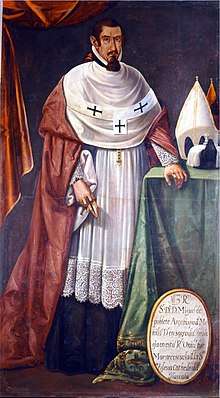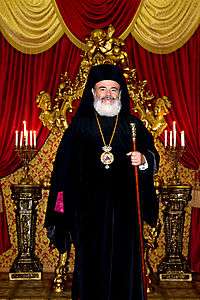Archbishop
In Christianity, an archbishop (/ˌɑːrtʃˈbɪʃəp/, via Latin archiepiscopus, from Greek αρχιεπίσκοπος, from αρχι-, 'chief', and επίσκοπος, 'bishop')[1][2][3] is a bishop of higher rank or office. In some cases, such as the Lutheran Church of Sweden and the Church of England, the title is borne by the leader of the denomination. Like popes, patriarchs, metropolitans, cardinal bishops, diocesan bishops, and suffragan bishops, archbishops are in the highest of the three traditional orders of bishops, priests (also called presbyters), and deacons. An archbishop may be granted the title or ordained as chief pastor of a metropolitan see or another episcopal see to which the title of archbishop is attached.

Early history
The earliest appearance of neither the title nor the role can be traced. The title of "metropolitan" was apparently well known by the 4th century, when there are references in the canons of the First Council of Nicæa of 325 and Council of Antioch of 341, though the term seems to be used generally for all higher ranks of bishop, including patriarchs. The term "archbishop" does not appear in the modern sense until the 6th century, although the role, above ordinary bishops but below patriarchs, seems to be established for metropolitans by the 5th century.[4]
Western Christianity
Metropolitan archbishops
Episcopal sees are generally arranged in groups in which one see's bishop has certain powers and duties of oversight over the others. He is known as the metropolitan archbishop of that see. In the Catholic Church, canon 436 of the Code of Canon Law indicates what these powers and duties are for a Latin Church metropolitan archbishop, while those of the head of an autonomous (sui iuris) Eastern Catholic Churches are indicated in canon 157 of the Code of Canons of the Eastern Churches. All Catholic metropolitans are archbishops, but not all archbishops are metropolitans, though most are.
Non-metropolitan archiepiscopal sees
As well as the much more numerous metropolitan sees, there are 77 Roman Catholic sees that have archiepiscopal rank.[5]:1142 In some cases, such a see is the only one in a country, such as Luxembourg[5]:423 or Monaco,[5]:474 too small to be divided into several dioceses so as to form an ecclesiastical province. In others, the title of archdiocese is for historical reasons attributed to a see that was once of greater importance.
Some of these archdioceses are suffragans of a metropolitan archdiocese; examples are the Archdiocese of Avignon, which is a suffragan of the Archdiocese of Marseille,[6] and the Archdiocese of Trnava, Slovakia. Others are immediately subject to the Holy See and not to any metropolitan archdiocese. These are usually "aggregated" to an ecclesiastical province. An example is the Archdiocese of Hobart in Australia, associated with the Metropolitan ecclesiastical province of Melbourne, but not part of it.[5]:296
The ordinary of such an archdiocese is an archbishop; however, especially in the Anglican Communion, not all archbishops' dioceses are called archdioceses.
Coadjutor archbishops
Until 1970, a coadjutor archbishop, one who has special faculties and the right to succeed to the leadership of a see on the death or resignation of the incumbent,[7] was assigned also to a titular see, which he held until the moment of succession. Since then, the title of Coadjutor Archbishop of the see is considered sufficient and more appropriate.
Archbishops ad personam
The rank of archbishop is conferred on some bishops who are not ordinaries of an archdiocese. They hold the rank not because of the see that they head but because it has been granted to them personally (ad personam). Such a grant can be given when someone who already holds the rank of archbishop is transferred to a see that, though its present-day importance may be greater than the person's former see, is not archiepiscopal. The bishop transferred is then known as the Archbishop-Bishop of his new see. An example is Gianfranco Gardin, appointed Archbishop-Bishop of Treviso on 21 December 2009.[8] The title borne by the successor of such an archbishop-bishop is merely that of Bishop of the see, unless he also is granted the personal title of Archbishop.
Titular archiepiscopal sees
The distinction between metropolitan sees and non-metropolitan archiepiscopal sees exists for titular sees as well as for residential ones. The Annuario Pontificio marks titular sees of the former class with the abbreviation Metr. and the others with Arciv.[5]:819
Many of the titular sees to which nuncios and heads of departments of the Roman Curia who are not cardinals are assigned are not of archiepiscopal rank. In that case the person who is appointed to such a position is given the personal title of archbishop (ad personam). They are usually referred to as Archbishop of the see, not as its Archbishop-Bishop.
Archbishops emeriti
If an archbishop resigns his see without being transferred to another, as in the case of retirement or assignment to head a department of the Roman Curia, the word emeritus is added to his former title, and he is called Archbishop Emeritus of his former see. Until 1970, such archbishops were transferred to a titular see.
There can be several Archbishops Emeriti of the same see: The 2008 Annuario Pontificio listed three living Archbishops Emeriti of Taipei.[9]
There is no Archbishop Emeritus of a titular see: An archbishop who holds a titular see keeps it until death or until transferred to another see.
In the Anglican Communion, retired archbishops formally revert to being addressed as "bishop" and styled "The Right Reverend",[10] although they may be appointed "archbishop emeritus" by their province on retirement, in which case they retain the title "archbishop" and the style "The Most Reverend", as a right.[11] Archbishop Desmond Tutu is a prominent example, as Archbishop Emeritus of Cape Town. Former archbishops who have not received the status of archbishop emeritus may still be informally addressed as "archbishop" as a courtesy,[12] unless they are subsequently appointed to a bishopric (not an archbishopric), in which case, the courtesy ceases.[13]
Privileges of archbishops
While there is no difference between the official dress of archbishops, as such, and that of other bishops, Roman Catholic metropolitan archbishops are distinguished by the use in liturgical ceremonies of the pallium, but only within the province over which they have oversight.[14]
Roman Catholic bishops and archbishops are styled "The Most Reverend" and addressed as "Your Excellency" in most cases. In English-speaking countries (except the United States), a Catholic archbishop is addressed as "Your Grace", while a Catholic bishop is addressed as "Your Lordship". Before December 12, 1930, the title "Most Reverend" was only for archbishops, while bishops were styled as "Right Reverend".[15] This practice is still followed by Catholic bishops in the United Kingdom to mirror that of the Church of England.
In Roman Catholic heraldry, an archbishop has an ecclesiastical hat called a galero with ten tassels on each side of his coat of arms, while a bishop has only six. The archiepiscopal cross behind the shield has two bars instead of one. Such a cross may be borne before him in liturgical processions.
In processions and other occasions where strict protocol is observed, archbishops are ranked higher than diocesan bishops in the order of precedence.
In the Anglican Communion, archbishops are styled "The Most Reverend" and addressed as "Your Grace", while bishops are styled "The Right Reverend" and addressed as "My Lord" or "Your Lordship". (In some countries, this usage is followed also by the Roman Catholic Church, but in others no distinction is made and "The Most Reverend" and "Your Excellency" are used for archbishops and bishops alike.) Anglican archbishops are entitled to be preceded by a server carrying an archiepiscopal processional cross (with two bars instead of one) in liturgical processions.[16] The Archbishop of Canterbury's metropolitical processional cross is always carried before him by a priest-chaplain, and (like other archbishops) is a two-barred processional cross. However, the Archbishop of Canterbury is also entitled to be preceded by the ancient primatial cross of Canterbury (still in ceremonial use) which is of an ornate historical design, made of precious metal, and with precious stones inserted, but unlike his metropolitical cross (or those of other archbishops) it is not double-barred.[17]
Eastern Christianity

Archbishops exist in all traditional denominations of the Eastern Christianity, including Eastern Orthodox Church, Oriental Orthodox Churches, Eastern Catholic Churches and others.
Eastern Orthodox Church
In the Eastern Orthodox Churches, the office and title of archbishop can be traced from the 4th and 5th century. Historically, the title was used variously, in terms of rank and jurisdiction.[18] In some Eastern Orthodox Churches, archbishops are ranked above metropolitans in precedence, while in others that order is reversed. Primates of autocephalous Eastern Orthodox Churches below patriarchal rank are generally designated as archbishops. In the Greek Orthodox Church, archbishops are ranked above metropolitans in precedence. The reverse is true for some Slavic Orthodox Churches (Russian Orthodox, Bulgarian Orthodox) and also for Romanian Orthodox Church, where metropolitans rank above archbishops.
In terms of jurisdiction, there are two basic types of archbishops in the Eastern Orthodox Church: real archbishops, and honorary archbishops. Real archbishops are primates of autocephalous or autonomous (regional) churches, and they have actual jurisdiction over other bishops, while honorary archbishops are in fact just diocesan bishops with honorary titles of archbishops and no jurisdiction outside their own diocese. The honorary title is usually conferred to bishops of historically important sees. For example, in the Serbian Orthodox Church, both types are represented: head of the autonomous Orthodox Ohrid Archbishopric is styled Archbishop of Ohrid and invested with regional jurisdiction over all diocesan bishops in North Macedonia, while diocesan bishop of the Eparchy of Montenegro and the Littoral, with seat in Cetinje, is given only the honorary title Archbishop of Cetinje, but without any jurisdiction over other diocesan bishops in Montenegro.
Oriental Orthodox Churches
The Oriental Orthodox custom generally agrees with the Slavic rather than the Greek with respect to the archbishop/metropolitan distinction.
Eastern Catholic Churches
Instead of the term archbishop, Eastern Catholic Churches sometimes use the word archeparch by analogy with eparch, the term used for a diocesan (or eparchial) bishop. However, the word archeparch is not found in the Code of Canons of the Eastern Churches.[19]
See also
- Apostolic succession
- Lists of patriarchs, archbishops, and bishops
References
- ἀρχιεπίσκοπος, ἐπίσκοπος. Liddell, Henry George; Scott, Robert; A Greek–English Lexicon at the Perseus Project.
- archiepiscopus. Charlton T. Lewis and Charles Short. A Latin Dictionary on Perseus Project.
- "archbishop". Online Etymology Dictionary.
- Messmer, Sebastian Gebhard (1907). . In Herbermann, Charles (ed.). Catholic Encyclopedia. 1. New York: Robert Appleton Company.
- Anon. (2012). Annuario pontificio. Vatican City: Libreria Editrice Vaticana. ISBN 978-88-209-8722-0.
- "Avignon (Latin (or Roman) Archdiocese) [Catholic-Hierarchy]". www.catholic-hierarchy.org. Retrieved 2019-06-14.
- "Code of Canon Law: text - IntraText CT". www.intratext.com. Retrieved 2019-06-14.
- "Friars Minor Conventual - Naming of the Archbishop-Bishop of Treviso, Italy". www2.ofmconv.pcn.net. Retrieved 2019-06-14.
- Annuario Pontificio 2008, p. 733
- "Addressing the Clergy". Church of England website. Archived from the original on 2011-11-17.
See note 3
- See the example of Archbishop David Moxon, for example.
- See "How to address the Clergy" in Crockford Clerical Directory, section "Archbishops", subsection "Notes".
- See final notes on the Archbishops page of Debretts forms of address.
- "Code of Canon Law: text - IntraText CT". www.intratext.com. Retrieved 2019-06-14.
- Canon Law Digest, Bouscaren, Vol. 1, Page 20. Rt. Rev. Dominic Laurence Graessel Archived 2013-02-05 at the Wayback Machine. Roman Catholic Archdiocese of Baltimore. Retrieved on 2016-11-19.
- This Anglican news agency page has photographs of two-barred crosses being carried by Archbishop George Carey and by Presiding Bishop Frank Griswold.
- The primatial cross is illustrated at the London SE1 community website.
- Meyendorff 1989.
- "CCEO: Alphabetical: A - IntraText CT". www.intratext.com. Retrieved 2019-06-14.
Sources
- Meyendorff, John (1989). Imperial unity and Christian divisions: The Church 450-680 A.D. The Church in history. 2. Crestwood, NY: St. Vladimir's Seminary Press.CS1 maint: ref=harv (link)


